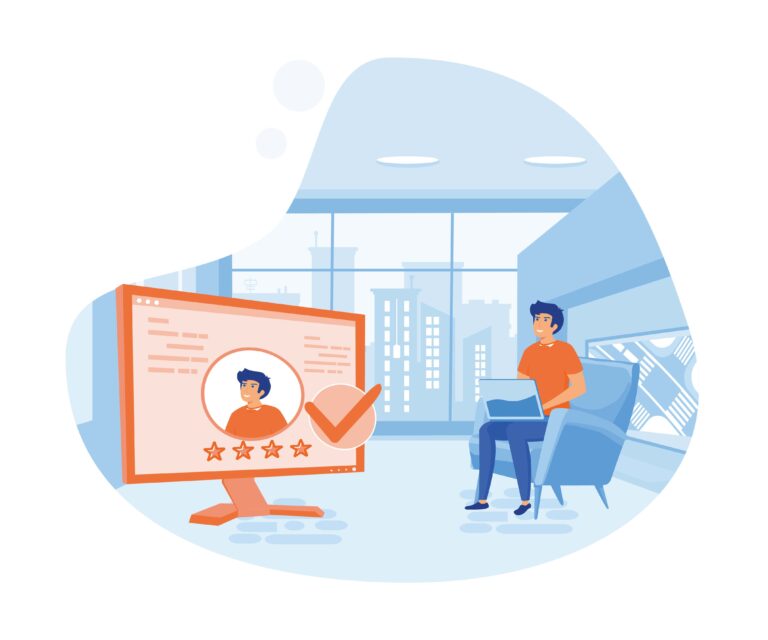Do you want to know how to advertise counseling services to bring in more clients?
You’re in the right place.
Advertising for therapists has never been easier!
Let’s jump right in.
1. Have A Website That is Optimized for Conversions
![Therapy Ads: 14 Mind-Blowing Ways to Advertise Your Private Practice [Update 2025] 1 Conversion funnel](https://johnsonjonesgroup.com/wp-content/uploads/2019/09/conversion-1.png)
It’s often difficult to think about your patients as clients with a value assigned to them. But just because your service is helping people, doesn’t mean you can’t grow it like any other business!
Your website is the most effective (or ineffective) tool for generating more clients for your therapy practice.
Whether or not your website sends you 200 leads a month or none at all will depend on how it’s set up.
First, let’s discuss the difference between an aesthetically pleasing site, and a website the is created with the sole purpose of generating leads for your Therapy Practice.
Web designers often create very beautiful websites.
![Therapy Ads: 14 Mind-Blowing Ways to Advertise Your Private Practice [Update 2025] 2 Beautiful. Just Beautiful. Upvote.](https://johnsonjonesgroup.com/wp-content/uploads/2019/09/beautiful-1.jpg)
The idea is if you have a better-looking aesthetic website, you will also somehow get more clients.
I have spoken with many therapists who were swayed by this idea and ended up with a gorgeous website that produced as many leads as the paperweight on their desk.
This image below is our home page which is optimized to generate leads for our marketing firm.
What do you notice about this page right off the bat?
Take a good look because next we will look at another website and discover what they should change to get more leads.
![Therapy Ads: 14 Mind-Blowing Ways to Advertise Your Private Practice [Update 2025] 3 therapist-marketing-page](https://johnsonjonesgroup.com/wp-content/uploads/2021/12/img_61bccaea7be76-1739137.-1024x506.png)
At first glance, you should see that there are only two clearly defined courses of action.
- We ask visitors to take advantage of our “Free Marketing Guide for Therapists.”
![Therapy Ads: 14 Mind-Blowing Ways to Advertise Your Private Practice [Update 2025] 4 Therapy Ads: 14 Mind-Blowing Ways to Advertise Your Private Practice [Update 2025] 1](https://johnsonjonesgroup.com/wp-content/uploads/2021/04/therapy-marketing-guide.png)
- We offer more information about “Packages & Pricing” in the top right corner of the page. This offers a free 30-minute Marketing Assessment to visitors.
![Therapy Ads: 14 Mind-Blowing Ways to Advertise Your Private Practice [Update 2025] 5 plans-and-pricing-guide](https://johnsonjonesgroup.com/wp-content/uploads/2021/12/plans-and-pricing-guide-2657938-1024x1024.jpg)
These two clear Calls To Action are key elements that differentiate a website that generates leads from one that doesn’t.
Everything else on the website leads back to these two calls to action.
Why?
Because our website’s one and only goal is to get information from our visitors so we can follow up with them. The website exists only to generate leads.
Let’s briefly look at some of the other features of our homepage and the purposes behind them.
The Menu Tab:
![Therapy Ads: 14 Mind-Blowing Ways to Advertise Your Private Practice [Update 2025] 6 screen-shot-2021-12-17-at-12-37-03-pm-8312074](https://johnsonjonesgroup.com/wp-content/uploads/2021/12/Screen-Shot-2021-12-17-at-12.37.03-PM-8312074-1024x774.png)
People who come to a pretty website end up clicking around your website. They hop from the ‘Home’ page to the ‘About’ page to the ‘Staff’ page, etc.
When people are allowed to bounce from one page of a website to another, they often get confused and don’t understand the goal of the interaction with the website.
Once they aren’t sure what the next step is, they go back to Google to find a site that makes things more simple (your competition).
People bouncing around from page to page on your website won’t get your therapy practice.
If it doesn’t accomplish the goal of generating leads, we don’t want it on the site. And that’s why you won’t see a navigation bar at the top of our website.
We minimize its impact by putting it all under one button – Menu
But let’s assume someone wants to click around anyway. Suppose they click ‘Menu.’
This is the menu they will find.
![Therapy Ads: 14 Mind-Blowing Ways to Advertise Your Private Practice [Update 2025] 7 services-5](https://johnsonjonesgroup.com/wp-content/uploads/2021/12/img_61bccaf203d01-4863827..png)
Notice at the bottom of the menu we again point visitors to the ‘Packages & Pricing’ page just like we did on our Home page.
But suppose the website visitor still wants to look into advertising services.
They then click “Advertising.” Take a look at what they will find.
![Therapy Ads: 14 Mind-Blowing Ways to Advertise Your Private Practice [Update 2025] 8 therapist-parketing-page](https://johnsonjonesgroup.com/wp-content/uploads/2021/12/img_61bccaf237ee4-4861714.-1024x501.png)
Look Familiar? It’s practically a carbon copy of the homepage, and that’s not because our web designers were being lazy.
It’s because the layout is highly efficient at generating leads. If we get lots of leads from our home page there is no reason to change the structure of other pages.
Notice the two main Calls To Action are front and center, in the same locations as they were on the homepage.
This creates order and consistency for visitors which reduces confusion and clarifies their next step.
Find Out How We Can Help Grow Your Business
Let’s discuss your marketing needs, and we’ll help you put together a digital marketing strategy that will generate more leads and save you time.
Chatbox Leads:
The only other way for visitors to take action on our website is our Chatbox.
Here is what a website viewer will see if they click our chatbox icon (on the lower right-hand side of the page).
![Therapy Ads: 14 Mind-Blowing Ways to Advertise Your Private Practice [Update 2025] 10 chat-box-with-jjg-2](https://johnsonjonesgroup.com/wp-content/uploads/2021/12/img_61bccb451dbbb-7110380..png)
You can see that we allow them to request a free marketing guide which was one of our goals on the homepage.
The other option is to speak with a person.
This also accomplishes the goal of our website. When we are asked a question through the chatbox we first request contact information from the website visitor.
All of the strategies we have discussed so far are combined to create a website that is highly optimized to convert website visitors into leads.
Your therapy practice’s website should also be set up to generate leads. Below are some things your website should not do.
Things Your Website Should and Should Not Do:
- Your website should not have a Navigation Menu with a bunch of buttons running across the top of your homepage (Home, About, Services, My Therapeutic Philosophy, etc). Visitors get lost and confused in menu buttons.
- There should be a clear call to action at the top of your homepage. If people have to search for their next step, they will most likely leave your website.
- There shouldn’t be more than two Calls To Action. This will confuse visitors.
- Website visitors should never have to search your site for a contact page or sign-up form. 90% or more of your website visitors won’t make it that far.
- Websites should not be text-heavy. People on the internet don’t read blocks of text. If you have full paragraphs, break them up or remove them altogether.
Let’s look at an example website and mentally critique it from what we’ve learned.
(I randomly chose this website and have removed all personal information from the image.)
How could the home page of the website below be optimized to generate leads more effectively?
![Therapy Ads: 14 Mind-Blowing Ways to Advertise Your Private Practice [Update 2025] 11 where-to-find-therapy](https://johnsonjonesgroup.com/wp-content/uploads/2021/12/img_61bccb02674a6-5556781..png)
What has this website done well:
- There aren’t a bunch of menu buttons at the top of the website.
- Visitors don’t have to search to find the contact page.
What this website could improve:
- The homepage is far too text-heavy.
- There is no clear call to action in the hero image (image at the top of the page).
- The next step for a visitor is hard to find (It’s at the bottom left under contact).
- The overall goal for the website viewer is unclear, it just feels like a bunch of information is being thrown out there.
Once you have a website that can generate leads for your therapy practice, it’s time to start sending people to your website.
2. Sign up for Top Directories
Directories are what I like to call a necessary evil. To stay competitive you really should show up in at least the large ones like Psychology Today.
![Therapy Ads: 14 Mind-Blowing Ways to Advertise Your Private Practice [Update 2025] 12 therapy-ads-on-psychology-today](https://johnsonjonesgroup.com/wp-content/uploads/2021/12/img_61bccb0391693-3798052..png)
Just like Yelp, These directories carry a lot of weight on Google which means they are going to show up first in the Google Search Engine Rankings (SERPs).
![Therapy Ads: 14 Mind-Blowing Ways to Advertise Your Private Practice [Update 2025] 13 therapists-near-me](https://johnsonjonesgroup.com/wp-content/uploads/2021/12/img_61bccb03de94d-8873205..png)
The downside is that it’s difficult to stand out on these platforms, even when you are paying for advertising.
We have found that it is easier to get a good return on investment by setting up a high-quality website (as described at the beginning of this post) and then sending traffic to it.
Getting this return on investment includes paying for Google Ads.
Because the ROI is generally higher for conversion-optimized websites, I typically suggest getting the most affordable directory listings so you at least show up when people are looking around.
Then spend the real advertising dollars on sending traffic into your lead capturing website.
3. Create a Google My Business Account
Google My Business is a fantastic way to get attention online.
![Therapy Ads: 14 Mind-Blowing Ways to Advertise Your Private Practice [Update 2025] 14 google-my-business-for-therapy-ads](https://johnsonjonesgroup.com/wp-content/uploads/2021/12/img_61bccb041c7cd-8510318.-1024x468.png)
When you create a Google My Business account you will show up in Google Maps and in the Google Map Pack.
Let’s discuss Google Maps first.
![Therapy Ads: 14 Mind-Blowing Ways to Advertise Your Private Practice [Update 2025] 15 google-maps-for-therapy](https://johnsonjonesgroup.com/wp-content/uploads/2021/12/img_61bccb05e060d-8234326.-1024x518.png)
Google Maps allows potential clients to get directions to your practice as well as other information. You can see this below:
![Therapy Ads: 14 Mind-Blowing Ways to Advertise Your Private Practice [Update 2025] 16 google-maps-for-therapy-2](https://johnsonjonesgroup.com/wp-content/uploads/2021/12/img_61bccb0a6ac67-2865690.-1024x568.png)
Google Maps is important because it is most frequently used on Mobile devices.
Google My Business also allows your business to show up in the map pack at the top of the Google Search Engine.
![Therapy Ads: 14 Mind-Blowing Ways to Advertise Your Private Practice [Update 2025] 17 map-pack-for-therapy](https://johnsonjonesgroup.com/wp-content/uploads/2021/12/img_61bccb0b841a0-7337627..png)
Above, you can see a Google search I did in Honolulu for “counselors near me.”
The top two listings are Google Advertisements (which we will discuss later).
Under these two Google Advertisements you will see a map.
The map itself and everything under it is the Google Map Pack.
It’s important that you sign your practice up for Google My Business because it can make the difference between your practice showing up at the top of Google or going completely unheard of.
You will notice the Google Map Pack listings you see on my screen show up above the fold.
This is a digital marketing term that means something important is visible on the screen without having to scroll down.
![Therapy Ads: 14 Mind-Blowing Ways to Advertise Your Private Practice [Update 2025] 18 google-search-for-therapists](https://johnsonjonesgroup.com/wp-content/uploads/2021/12/img_61bccb0c64e3e-7100134.-1024x576.png)
Your business information should (ideally) show up above the fold on the Google search results page.
This is really important. Showing up above the fold on the first page of Google tremendously increases your chances of being clicked on.
As far as I’m concerned, signing up for Google My Business is a two for one deal.
![Therapy Ads: 14 Mind-Blowing Ways to Advertise Your Private Practice [Update 2025] 19 tok-toink](https://johnsonjonesgroup.com/wp-content/uploads/2021/12/img_61bccb0e8b1ec-9656982..jpg)
You get your counseling practice on Google Ads and you get in the Google Map Pac. And it’s FREE!
Take advantage of this marketing strategy as soon as you can.
You can sign up for Google My Business at the link provided.
4. Create Audience Specific Landing Pages
A landing page is a page that is designed specifically to get potential clients to do one thing and one thing only.
Therapists should be trying to generate leads on their landing pages.
![Therapy Ads: 14 Mind-Blowing Ways to Advertise Your Private Practice [Update 2025] 20 landing-page-for-your-therapy-ads](https://johnsonjonesgroup.com/wp-content/uploads/2021/12/img_61bccb0ee0b3d-8271969..png)
This means you want people looking at your website to leave their name, phone number and email behind before they leave.
Over 95% of the people who visit your website will not book a consultation or call you. So you have to make things easier.
This means asking for less commitment and less work on their part.
The home page (and almost every other page) of our own website is an example of a landing page.
![Therapy Ads: 14 Mind-Blowing Ways to Advertise Your Private Practice [Update 2025] 21 johnson-jones-group-therapist-marketing](https://johnsonjonesgroup.com/wp-content/uploads/2021/12/img_61bccb0f542ef-3948161.-1024x506.png)
There are no distractions, and every Call To Action is designed to encourage private practice owners to leave behind information so we can follow up with them.
This works INSANELY well for us and it will work for your counseling practice as well.
5. Run Google Ads
We have found Google ads to be a quick win for our therapy practice clients.
![Therapy Ads: 14 Mind-Blowing Ways to Advertise Your Private Practice [Update 2025] 22 google-ads-for-your-therapy](https://johnsonjonesgroup.com/wp-content/uploads/2021/12/img_61bccb152d2c3-9019531.-1024x495.png)
While you do have to pay for advertisements on Google, if your marketing system is set up correctly you should see a pretty nice return on investment.
There are different types of Google Advertisements.
We have found the most effective type of ads are Search Ads. You can see Google Search Ad in the image below:
![Therapy Ads: 14 Mind-Blowing Ways to Advertise Your Private Practice [Update 2025] 23 therapy-ads-on-google](https://johnsonjonesgroup.com/wp-content/uploads/2021/12/img_61bccb18107d4-6271210..png)
Ads for therapists are typically inexpensive compared to other business industries. It’s a relatively unsaturated market.
The other pro of advertising on Google Ads is that you only pay when someone clicks on your advertisement.
The downside is that it does take some experience to run highly optimized advertising campaigns.
I have met a good number of therapists running their own ads who don’t realize they are wasting a lot of money by trying to show ads to keywords like “Therapists”.
This keyword is far too general to know if someone is looking for therapy.
If caution isn’t taken, it can be easy to spend money that won’t bring you any clients.
Overall, however, if Google Ads is done right, it’s definitely the most effective method of advertising for therapists.
You can get your free Google Ads account at the link provided.
If you’re loving this post, you might also like our post Marketing for Therapists: 7 Unbeatable Marketing Strategies for Therapists
6. Run Facebook Ads
Facebook ads for consumer services are typically most effective at increasing brand awareness.
This can be useful for larger, well-established practices that aren’t worried about directly converting traffic into clients.
The other reason why this advertising method is better for brand building is due to the nature of Facebook.
I have heard it said that Facebook is like a party and Google is like a shopping mall.
People on facebook are scrolling around and looking at things with no purpose. They’re having a party, talking to friends, chatting, scrolling, etc. For this reason, they are likely to see your ad but they are less likely to engage with it.
Google, on the other hand, is more like the mall.
If someone wants to buy a TV, they look up TVs, click the first Amazon product that comes up. They then look at TVs on Amazon until they pick one.
![Therapy Ads: 14 Mind-Blowing Ways to Advertise Your Private Practice [Update 2025] 24 ranking-on-google-for-therapy-ads](https://johnsonjonesgroup.com/wp-content/uploads/2021/12/img_61bccb1885a4b-9549633.-1024x706.png)
You will notice there isn’t much time wasted on Google.
Nobody goes to the mall to stand in the mall’s entryway. The mall is just the means to get to the store with the “best tv”.
Nobody is hanging out on Google. Google is just the conduit.
Google searchers are looking for something specific.
If your ad shows up first, you have a good chance of getting that person to engage with your brand.
7. Build Trust With Microtransactions
When people visit your website, they need to build trust in the relationship before they will commit to working with you.
People want to do a mini-transaction or test purchase with you to see if you’re someone they can trust.
For this reason, you need to offer a free hand-raiser.
![Therapy Ads: 14 Mind-Blowing Ways to Advertise Your Private Practice [Update 2025] 25 free](https://johnsonjonesgroup.com/wp-content/uploads/2021/12/img_61bccb1a7b553-6120914..jpg)
This means you are offering something valuable in exchange for the potential client’s information.
This is the hand-raiser we use on our homepage to begin building that relationship with counselors.
This hand-raiser also does something else that is incredibly helpful.
You won’t need to wait around hoping someone stumbles onto your ‘Contact’ page and chooses to schedule an appointment.
Instead, everyone who is interested enough to download your free brochure will be giving you their phone number and email.
When you are following up with these incoming leads (phone, text, email), you are dramatically increasing your odds of getting new clients.
Proof of Concept: In this article, there is a call to action which asks readers to download our Ultimate Marketing Guide that you see in the image above.
When someone fills out the form, guess who they are going to hear from within a few hours? Yours Truly.
Why am I telling you the marketing strategy we use? Because it works. And if the marketing strategy works for the marketing agency, you can bet it will work for counseling practices too.
8. Create A Content Marketing Strategy
What’s content marketing? Well, firstly it’s a great way to get FREE traffic from Google to your website.
Most people think blogs are this thing you write that nobody ever sees.
![Therapy Ads: 14 Mind-Blowing Ways to Advertise Your Private Practice [Update 2025] 27 content-marketing](https://johnsonjonesgroup.com/wp-content/uploads/2021/12/img_61bccb1be362b-3603307.-1024x683.jpg)
In reality, a good piece of content is written specifically for the people who are looking for the services you offer.
A fully cooked piece of content will rank at the top of Google, attracting targeted Google searchers into your website, for free.
How do I know this works?
Well, you are reading a blog written for therapists who own or run a private practice and want to know more about how to advertise their services.
Does this sound like anyone you know? When you know who your target audience is, you can speak directly to them in your blog content.
![Therapy Ads: 14 Mind-Blowing Ways to Advertise Your Private Practice [Update 2025] 28 target-audiences-for-therapy-ads](https://johnsonjonesgroup.com/wp-content/uploads/2021/12/img_61bccb1d72530-7088687..png)
You probably also happened across this blog on Google or another major search engine.
All the while you’re getting top-notch marketing information (at least I hope) and you feel like your getting to know me a little better at the same time.
In my experience, content marketing works really well to build relationship and trust with potential clients.
![Therapy Ads: 14 Mind-Blowing Ways to Advertise Your Private Practice [Update 2025] 29 making-content-online-for-therapy-ads](https://johnsonjonesgroup.com/wp-content/uploads/2021/12/img_61bccb1dbafd5-5262430..png)
Content marketing takes more time to create because:
- Writing it takes planning and forethought.
- It also takes time to be listed and rise in the Google rankings.
- There are also a number of rules Google expects blog posts to follow in order to rank well in Google.
Using these rules to your advantage is often called Search Engine Optimization or Search Engine Marketing:
![Therapy Ads: 14 Mind-Blowing Ways to Advertise Your Private Practice [Update 2025] 30 seo-for-therapy-ads](https://johnsonjonesgroup.com/wp-content/uploads/2021/12/img_61bccb1e0630b-5126903..jpg)
I have listed just a few of these rules below:
- The blog should be 1,900 words or more to rank well on Google.
- The blog should have lots of interactive content like images, calls to action, calendar booking ability, videos, etc. (This is called rich content).
- The blog should have a good number of external links to other websites and internal links to your own website.
- The title should include the specific keyword you are trying to rank your blog for (This blog’s keyword is “Therapy Ads”).
- The blog should have an H1 tag and follow up H2 tags
Getting your content to rank on Google is a fantastic way to increase the number of potential clients entering your sales funnel.
9. New Client Follow-up Automation
When new clients sign up for the free hand-raiser on your website, they should go into an automation sequence that will follow up with them via email and text.
![Therapy Ads: 14 Mind-Blowing Ways to Advertise Your Private Practice [Update 2025] 31 follow-ups-for-therapy-ads](https://johnsonjonesgroup.com/wp-content/uploads/2021/12/img_61bccb1e2bded-1569706..jpg)
The main goal of these automated messages is to get the client to book an appointment.
You should supplement automated messages with more personal phone calls as well.
![Therapy Ads: 14 Mind-Blowing Ways to Advertise Your Private Practice [Update 2025] 32 chating-online](https://johnsonjonesgroup.com/wp-content/uploads/2021/12/img_61bccb1e59aae-3404990.-1024x673.png)
One study showed that if you call a potential client within 1 hour of them signing up on your website, you’re 300% more likely to seal the deal.
You can support your clients even further by setting them up on an automated 4 to 6-week email campaign that gives them more information about overcoming whatever difficulty they are facing.
We use a customized version of Active Campaign to get our clients set up on these automation systems.
![Therapy Ads: 14 Mind-Blowing Ways to Advertise Your Private Practice [Update 2025] 33 active-campaign-for-therapy-ads-2](https://johnsonjonesgroup.com/wp-content/uploads/2021/12/img_61bccb5f24d56-3146130..png)
10. Past Client Follow-Up Automation
The same automation process can be used to re-engage past clients.
- Set up your automation to send birthday wishes on your former clients special day.
- You can also send automated follow-ups when clients don’t show up for appointments or if you haven’t heard from them in a while.
You won’t regret spending the time to get your clients set up on these types of automated system. Your clients will feel cared for and will stay engaged with your brand.
![Therapy Ads: 14 Mind-Blowing Ways to Advertise Your Private Practice [Update 2025] 34 Waiting for you](https://johnsonjonesgroup.com/wp-content/uploads/2019/09/i-miss-you-waiting-for-you-memes-1-2.jpg)
Bonus Tip: If you need to book some clients quickly, you can send email campaigns to your entire list of past and potential clients.
Offering your email list (of a few hundred or few thousand people) a time-limited special on services is a great way to ensure a couple of bookings.
Example Offer: The first 6 people to reply will get ____ off their next counseling session. Hurry, This offer is only good for 48 hours!
11. Claim Your Yelp Profile
Yelp is a massive website that lists businesses and their contact information.
![Therapy Ads: 14 Mind-Blowing Ways to Advertise Your Private Practice [Update 2025] 35 yelp-2](https://johnsonjonesgroup.com/wp-content/uploads/2021/12/img_61bccb20ae690-4576349.-1024x498.png)
Because Yelp is so large, it naturally shows up at the top of the Google Search Engine Rankings (SERPs).
For example, I went on Google and searched “counselors near me” and the third listing was Yelp.
*The first two listings were both from Psychology Today.
At least in the search, Yelp ranks above every other directory listing. That’s significant and there is a good chance most of your competition is overlooking it.
![Therapy Ads: 14 Mind-Blowing Ways to Advertise Your Private Practice [Update 2025] 36 google-search-page-for-therapy-ads](https://johnsonjonesgroup.com/wp-content/uploads/2021/12/img_61bccb2177357-2207726..png)
You can capitalize on this by creating a Yelp account and claiming your FREE profile.
You can see in the image below that we have “claimed” our profile.
![Therapy Ads: 14 Mind-Blowing Ways to Advertise Your Private Practice [Update 2025] 37 yelp-for-therapy-ads](https://johnsonjonesgroup.com/wp-content/uploads/2021/12/img_61bccb21ae73d-6380075..png)
You can claim your Yelp profile by clicking the link provided.
12. Collect Online Reviews
Online reviews are a powerful and 100% necessary form of social proof.
This is another way to build trust with people who have never met you before.
Here is an example of one review from our home page.
![Therapy Ads: 14 Mind-Blowing Ways to Advertise Your Private Practice [Update 2025] 38 client-stories-are-key-for-therapy-ads](https://johnsonjonesgroup.com/wp-content/uploads/2021/12/img_61bccb2223b8b-6716553.-1024x396.png)
If you are serious about increasing your business, you will create a plan to get lots of AWESOME reviews to win potential clients.
Put placards at strategic locations (like your office, waiting room, and in restrooms) that request people to take a moment to review you on Google.
If you want to take it one step further, offer $10 off the client’s next visit (or some other worthwhile incentive) if they review your business.
This is worth its weight in gold and can be done for your Google My Business listing, Yelp, your website, and others.
Let’s look at just two Yelp profiles that popped up when I searched for ‘counselors near me.’
The majority of people will choose the one with better reviews.
![Therapy Ads: 14 Mind-Blowing Ways to Advertise Your Private Practice [Update 2025] 39 reviews-for-therapy-ads](https://johnsonjonesgroup.com/wp-content/uploads/2021/12/img_61bccb24b7ff1-2965876..png)
Now, imagine your business’ listing is sitting under “Xplor Counseling”, except you had a plan to get excellent reviews… and you have 74 of them.
There is no contest, people are going to pick you every time.
13. Submit Blogs & Articles to Reporters
You can boost your reputation as an industry expert by creating a profile on Help A Reporter Out.
![Therapy Ads: 14 Mind-Blowing Ways to Advertise Your Private Practice [Update 2025] 40 therapy-ads-using-blogs-and-articles](https://johnsonjonesgroup.com/wp-content/uploads/2021/12/img_61bccb2512068-6447230.-1024x343.png)
Every day you will get emails with lists of reporters looking for sources for their articles.
You can submit some of your writing to them and if it’s chosen you will be featured in local or national papers.
This is also great information to add to your bio (As seen in the New York Times).
And the answer is yes, you can get into major publications with a little luck and by sending in high-quality material.
![Therapy Ads: 14 Mind-Blowing Ways to Advertise Your Private Practice [Update 2025] 41 media-outlets-using-haro](https://johnsonjonesgroup.com/wp-content/uploads/2021/12/img_61bccb2965f66-9433564..png)
You can create your FREE HARO account at the link I provided.
You can also sign up for another very similar service called ProfNet at the link provided.
14. Create Strategic Referral Programs
You did the hard work it takes to win over your current clients and you helped them work through some difficult problems.
You also built a professional relationship at the same time.
Let them do some of the work for you now. Create incentives for clients to send their friends your way.
And that’s it!
I hope you enjoyed this article on how to advertise counseling services with effective therapy ads and marketing strategies.
If you would like to set-up a free 30-minute marketing assessment, you’re welcome to schedule a time at the calendar below.
Feel free to book a FREE consultation with me (Dillon Jones) to discuss your marketing strategy for this year.
You can book a free 30 min marketing assessment here:







